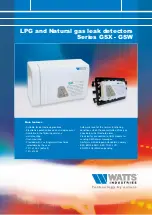
8
Instructions for use
|
Dräger PointGard 2000 Series
en
|
Conventions in this document
– The wiring for the optional relay module must be selected
and fused according to the rated voltages, currents and
environmental conditions.
– Voltage differences can cause insulation faults. Do not mix
electric loads with different voltage types (AC or DC).
Using DC loads, ensure that relay contacts only control
devices with the same DC voltage rating. Using AC loads,
ensure that relay contacts are only connected to devices
sharing a common phase.
1.5 Commissioning
– Ensure wiring for relays and connections for sensor are
made before applying power.
– Before leaving the instrument for normal operation, check
the configuration and calibration for the proper settings.
1.5.1 Calibration
– For proper operation, never adjust the span before
completing zero adjustment. Performing these operations
out of order will cause the calibration to be faulty.
– If the intended operation is at high altitudes, the reading
will be lower than the reading at sea level (reduced partial
pressure). A new span calibration is recommended if the
altitude or the ambient pressure is changed. The factory
calibration is set to sea level.
– Dräger recommends calibrating instruments with target
gas. This method is more accurate than a surrogate gas
calibration. A surrogate gas calibration may only be
performed as an alternative if a target gas calibration is
not possible.
– Methane and hydrogen should be calibrated with target
gas only and not calibrated with a surrogate gas.
1.6 During
operation
Risk of electric shock
Opening the instrument during operation can result in an
electric shock.
►
Disconnect power from the instrument and wait at least 1
minute before continuing.
1.6.1 Maintenance
– The maintenance intervals must be established for each
individual installation. Depending on safety considerations
and application specific conditions the instrument is used
in, these might need to be shortened.
– Refer to the maintenance section in the transmitter
instructions for use.
2
Conventions in this document
2.1 Meaning of the warnings
The following warnings are used in this document to alert the
user to potential dangers. A definition of the meaning of each
warning is as follows:
2.2 Typographical
conventions
2.3 Trademarks
The following webpage lists the countries in which Dräger's
trademarks are registered: www.draeger.com/trademarks.
3 Description
3.1 Drawing
legend
For figures, refer to the fold-out page..
Alert icon Signal word
Warning classification
WARNING
Indicates a potentially hazard-
ous situation. If not avoided, it
could result in death or serious
injury.
CAUTION
Indicates a potentially hazard-
ous situation. If not avoided, it
could result in physical injury. It
may also be used to alert
against unsafe practices.
NOTICE
Indicates a potentially hazard-
ous situation. If not avoided, it
could result in damage to the
product or environment.
Text
Texts in bold type identifies labels on the device
and screen texts.
►
This triangle indicates the possibilities for avoiding
the hazard in warnings.
>
The greater-than sign indicates a navigation path
in a menu.
This symbol indicates information that facilitates
the use of the product.
Trademark
Trademark owner
Polytron
®
Dräger
DrägerSensor
®
Dräger
HART
®
HART Communication Foundation
PointGard 2xx0 Series
1
Horn
2
Screws to lock/unlock the cover
3
Port for 4-20mA interface
4
Cable gland for power supply cable
5
Port for relay cables
6
PCB unit
7
Slot for sensor dongle
8
DIP switch









































